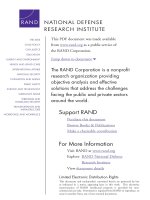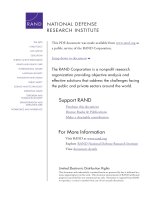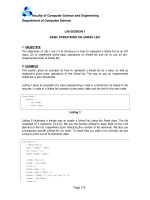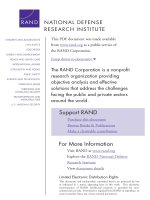Measuring the Statutory and Regulatory Constraints on Department of Defense Acquisition - An Empirical Analysis pptx
Bạn đang xem bản rút gọn của tài liệu. Xem và tải ngay bản đầy đủ của tài liệu tại đây (712.91 KB, 105 trang )
This document and trademark(s) contained herein are protected by law as indicated in a
notice appearing later in this work. This electronic representation of RAND intellectual
property is provided for non-commercial use only. Permission is required from RAND
to reproduce, or reuse in another form, any of our research documents.
Limited Electronic Distribution Rights
Visit RAND at www.rand.org
Explore RAND National Defense Research Institute
View document details
For More Information
Purchase this document
Browse Books & Publications
Make a charitable contribution
Support RAND
This PDF document was made available from www.rand.org as
a public service of the RAND Corporation.
6
Jump down to document
The RAND Corporation is a nonprofit research
organization providing objective analysis and
effective solutions that address the challenges facing
the public and private sectors around the world.
THE ARTS
CHILD POLICY
CIVIL JUSTICE
EDUCATION
ENERGY AND ENVIRONMENT
HEALTH AND HEALTH CARE
INTERNATIONAL AFFAIRS
NATIONAL SECURITY
POPULATION AND AGING
PUBLIC SAFETY
SCIENCE AND TECHNOLOGY
SUBSTANCE ABUSE
TERRORISM AND
HOMELAND SECURITY
TRANSPORTATION AND
INFRASTRUCTURE
WORKFORCE AND WORKPLACE
This product is part of the RAND Corporation monograph series. RAND
monographs present major research findings that address the challenges facing
the public and private sectors. All RAND monographs undergo rigorous peer
review to ensure high standards for research quality and objectivity.
Measuring the
Statutory and Regulatory
Constraints on Department
of Defense Acquisition
An Empirical Analysis
Jeffrey A. Drezner, Irv Blickstein, Raj Raman, Megan McKernan,
Monica Hertzman, Melissa A. Bradley, Dikla Gavrieli, Brent Eastwood
NATIONAL DEFENSE RESEARCH INSTITUTE
Prepared for the Office of the Secretary of Defense
Approved for public release; distribution unlimited
The RAND Corporation is a nonprofit research organization providing
objective analysis and effective solutions that address the challenges
facing the public and private sectors around the world. RAND’s
publications do not necessarily reflect the opinions of its research clients
and sponsors.
R
®
is a registered trademark.
© Copyright 2007 RAND Corporation
All rights reserved. No part of this book may be reproduced in any
form by any electronic or mechanical means (including photocopying,
recording, or information storage and retrieval) without permission in
writing from RAND.
Published 2007 by the RAND Corporation
1776 Main Street, P.O. Box 2138, Santa Monica, CA 90407-2138
1200 South Hayes Street, Arlington, VA 22202-5050
4570 Fifth Avenue, Suite 600, Pittsburgh, PA 15213-2665
RAND URL: />To order RAND documents or to obtain additional information, contact
Distribution Services: Telephone: (310) 451-7002;
Fax: (310) 451-6915; Email:
The research described in this report was prepared for the Office of the
Secretary of Defense (OSD). The research was conducted in the RAND
National Defense Research Institute, a federally funded research and
development center sponsored by the OSD, the Joint Staff, the Unified
Combatant Commands, the Department of the Navy, the Marine Corps,
the defense agencies, and the defense Intelligence Community under
Contract W74V8H-06-C-0002.
Library of Congress Cataloging-in-Publication Data
Measuring the statutory and regulatory constraints on Department of Defense
acquisition : an empirical analysis / Jeffrey A. Drezner [et al.].
p. cm.
Includes bibliographical references.
ISBN 978-0-8330-4176-0 (pbk. : alk. paper)
1. United States. Dept. of Defense—Procurement—Evaluation. 2. United States.
Dept. of Defense—Rules and practice. I. Drezner, Jeffrey A. II. United States. Dept.
of Defense. III. Title: Measuring the statutory and regulatory constraints on DoD
acquisition, an empirical analysis.
UC263.M419 2006
355.6'2120973—dc22
2007030594
iii
Preface
Over the past two decades, the Department of Defense (DoD) has been striving to
make acquisition-related statutes and regulations less burdensome to program offices.
Many studies have focused on the costs of doing business with DoD, but few have
attempted to quantify the actual cost of compliance.
e Office of the Under Secretary of Defense for Acquisition, Technology, and
Logistics (OUSD/AT&L) requested RAND National Defense Research Institute
(NDRI) to quantify the impact of statutes and regulations that are burdensome to
program offices. RAND approached this overall research project by (1) identifying
which statutes and regulations are perceived as burdensome, (2) developing and vali-
dating a methodology to quantify that burden, (3) collecting quantifiable information
from program offices, and (4) suggesting relief measures to alleviate the burdensome
tasks where possible. is report presents the results of this research. Details of the
methodology are discussed in a separate report.
1
is report should be of interest to program offices, program executive offices
within the Military Services, the Office of the Secretary of Defense (OSD), Congress,
and contractors with an interest in acquisition policy, processes, and reform.
is research was sponsored by the Office of the Under Secretary of Defense for
Acquisition, Technology, and Logistics (OUSD/AT&L) and conducted within the
Acquisition and Technology Policy Center of the RAND National Defense Research
Institute, a federally funded research and development center sponsored by the Office
of the Secretary of Defense, the Joint Staff, the Unified Combatant Commands, the
Department of the Navy, the Marine Corps, the defense agencies, and the defense
Intelligence Community.
For more information on RAND’s Acquisition and Technology Policy Center,
contact the Director, Philip Antón. He can be reached by email at atpc-director@rand.
org; by phone at 310-393-0411, extension 7798; or by mail at the R AND Corporation,
1776 Main Street, Santa Monica, California 90407-2138. More information about
RAND is available at www.rand.org.
1
Drezner et al., 2006.
v
Contents
Preface iii
Figures
vii
Tables
ix
Summary
xi
Acknowledgments
xv
Abbreviations
xvii
CHAPTER ONE
Introduction 1
Background and Objectives
1
e Hypothesis
3
Report Organization
4
CHAPTER TWO
Methodology Revisited 7
Overview and Processes
8
Program Selection and Descriptions
8
Data Collection
10
Data Cleaning and Coding
13
Caveats
15
CHAPTER THREE
Results by Statutory and Regulatory Area 17
Aggregate Results
17
Clinger-Cohen Act and Information Management
21
Core Law and 50-50 Rule
23
Program Planning and Budgeting
25
Program Status Reporting
28
Testing
30
Other
33
Sensitivity Analysis
34
vi Measuring the Statutory and Regulatory Constraints on Department of Defense Acquisition
CHAPTER FOU
R
Special Interest Results 37
An Individual’s Time
37
Senior and Nonsenior Participants
39
For Whom Was the Activity Performed?
43
Discrete Events and Processes
44
DAB-level Interim Program Review Activity
48
Restructuring a Major Modification Program
51
CHAPTER FIVE
Conclusions 55
Comparison with Similar Research
57
Policy Implications and Recommendations
59
Suggested Areas for Future Research
61
APPENDIX A
Program Data by Statutory and Regulatory Area 63
Bibliography
79
vii
Figures
1.1 e Hypothesis Being Tested 3
3.1 Compliance Level of Effort as a Percentage of Total Available Hours
18
3.2 Distribution of Time Spent Across Regulatory Areas (1)
18
3.3 Distribution of Time Spent Across Regulatory Areas (2)
19
3.4 Program Office Effort in the CCA Regulatory Area
21
3.5 Program Office Effort in the Core Law and 50-50 Rule Regulatory Area
24
3.6 Program Office Effort in the PPB Regulatory Area
26
3.7 Level of Effort for What-if Exercises
27
3.8 Program Office Effort in the PSR Regulatory Area
29
3.9 Level of Effort for PSR “Other”
30
3.10 Program Office Effort in the Testing Regulatory Area
31
3.11 Program Office Effort in the “Other” Regulatory Area
33
4.1 Proportion of Time Spent on Compliance Activities
by Each Study Participant (1)
38
4.2 Proportion of Time Spent on Compliance Activities
by Each Study Participant (2)
39
4.3 Total Senior-Level and Nonsenior-Level Hours by Regulatory Area
Across All Seven Programs
41
4.4 Senior-Level versus Nonsenior-Level Cumulative Person-Equivalents
by Program
42
4.5 DAB IPR Activity, Program A
51
4.6 Restructuring a Major Modification, Program G
54
5.1 Debunking the Myth
56
ix
Tables
2.1 Summary Participation at Each Program Office 12
3.1 Annual Level of Effort for CCA Compliance by Program
22
3.2 Annual Level or Effort for Core/50-50 Compliance by Program
24
3.3 Annual Level of Effort for PPB Compliance by Program
27
3.4 Annual Level of Effort for PSR Compliance by Program
29
3.5 Annual Level of Effort for Test Compliance by Program
32
3.6 Sensitivity Analysis of Top-Level Results
35
4.1 Average Hours per Nonsenior and Senior-Level Worker by Regulatory Area
41
4.2 Average Hours per Nonsenior and Senior-Level Worker by Program
43
4.3 For Whom Was the Compliance Activity Performed?
45
4.4 Selected Activities Associated with Selected Events and Processes
46
4.5 Preparation Activities for DAB IPR, Program A
50
4.6 Restructuring a Major Modification, Program G
53
A.1 User Information and Hours for Program A (By Reporting Period)
64
A.2 User Information and Hours for Program B (By Reporting Period)
66
A.3 User Information and Hours for Program C (By Reporting Period)
68
A.4 User Information and Hours for Program D (By Reporting Period)
70
A.5 User Information and Hours for Program E (By Reporting Period)
72
A.6 User Information and Hours for Program F (By Reporting Period)
74
A.7 User Information and Hours for Program G (By Reporting Period)
76
xi
Summary
Improving the defense acquisition process has been a recurring theme for several
decades. Acquisition process reforms often require changes in the body of statutes and
regulations governing the acquisition process. Prior research has observed a “regulatory
pendulum” in which statutes and regulations seem to move back and forth from relative
flexibility to relative rigidity in response to perceived problems in the acquisition pro-
cess generally, or in specific weapon system programs. Increased flexibility enables pro-
gram managers to tailor their program’s acquisition strategy to the unique features of its
environment and to reduce the costs of oversight. Rigidity in statutes and regulations
mandates specific management approaches and oversight procedures. Program manag-
ers often complain that the periods of relative rigidity constrain their ability to manage
their program effectively and impose real, non-value-added costs on the program.
is research addresses the perceived problem of overly burdensome statutes and
regulations directly. e objective of this research was to quantify and document the
effects of a specific statute or regulation on a specific weapon system program. While
many other studies have addressed this topic, few have succeeded in generating the
empirical evidence needed to inform the policy debate with more than just anecdotes.
is research tests the hypothesis that the statutes and regulations governing
defense acquisition programs place constraints on those programs that significantly
affect the program manager’s ability to manage the program. ere is a widespread
perception in the acquisition community that significant portions of program office
staff spend an inordinate amount of time responding to statutes and regulations
through formal compliance activities and informal processes that have developed
around those activities. Much of that compliance-related time is perceived as burden-
some, with purported consequences of schedule delays, additional incurred costs, loss
of weapon system capability, increased demands on critical program staff, and other
impacts on program execution and outcomes.
As described in our Phase 1 report,
1
we developed a Web-based data collection
tool that enabled participants to input the time spent on specific compliance-related
activities and provide comments related to those activities. e data collection tool
1
Drezner et al., 2006.
xii Measuring the Statutory and Regulatory Constraints on Department of Defense Acquisition
listed all the compliance activities we had identified in each of five regulatory areas:
Clinger-Cohen Act, Core Law and 50-50 Rule, program planning and budgeting, pro-
gram status reporting, and testing. e tool provided space to report other compliance
activities in each area as well as other statutory or regulatory areas of interest to indivi-
dual participants. We recruited seven program offices as participants and asked that
they identify all program office and associated personnel who perform activities relevant
to those five areas. We asked those identified individuals to enter data (hours worked
on specific activities and any associated comments) every two weeks for a 12-month
period. We assembled interim results for each program and reviewed those results with
each program every two to three months to validate the information provided. Overall,
316 individuals in the seven program offices participated during the study field period.
ese individuals included program managers, deputy program managers, product
managers, and branch chiefs, as well as personnel within the functional areas associ-
ated with the five statutory and regulatory areas of interest.
e results were rather surprising:
e total reported time spent on compliance activities in the five statutory and
regulatory areas we addressed was less than 5 percent of the total staff time avail-
able to each program office.
Most program office officials do not work full time on compliance activities in
these five areas. In fact, the vast majority of participants reported considerably less
than 20 percent of their total work time as relating to compliance activities in the
five areas studied.
Most compliance-related activities are performed in reference to a Service request
or requirement, rather than OSD, Government Accounting Office (GAO), or
other program stakeholders.
In discussions and in their comments input to the Web-based data protocol, par-
ticipants emphasized process-related issues (i.e., implementation—the details of
how compliance is achieved) rather than the intent of a statute or regulation. Par-
ticipants recognized that many of these “compliance” activities need to be accom-
plished regardless of whether they are mandated.
Few serious complaints were recorded about policies or processes within these five
statutory or regulatory areas, and reported hours are not correlated with com-
plaints. at is, the majority of complaints reflect the participant’s view that the
activity was burdensome, even if it took little time to accomplish. e explanation
appears to be that deviations from an individual’s perceived normal job functions
are often perceived as burdensome.
ere is little evidence of actual consequences to program execution or outcomes
as a result of the compliance activities we tracked. We could identify only a single
example in which a firm link could be established between a statute and its associ-
ated regulatory processes and program cost and schedule outcomes.
•
•
•
•
•
•
Summary xiii
Programs are indeed governed by a large and confusing array of statutes and regula-
tions, and those statutes and regulations do place constraints on program execution.
But program office staff do not appear to spend a significant amount of their time com-
plying with those statutes and regulations, nor is much of that compliance time per-
ceived as burdensome. Lastly, there are few adverse consequences to program outcomes
due to compliance activities associated with the statutes and regulations we studied.
ese findings do not mean that regulatory compliance is without costs, and
some compliance activities may indeed be non-value added or burdensome. Many pro-
gram office personnel who have not formally tracked time spent on such activities cer-
tainly perceive that they spend a significant amount of time complying with statutes
and regulations perceived as non-value added or burdensome; however, no evidence
supports this perception. It was notable that our study participants began with this
view, but ended the study agreeing that perhaps the difference between perception and
reality was significant.
We made several observations over the course of the study that suggest ways to
mitigate some of the perceived burden that was reported:
Both the perceived burden and reported time spent in compliance activities were
driven largely by the unique characteristics of the program and the challenges and
issues it is currently facing. is argues for a high degree of flexibility and tailor-
ing of compliance activities, balanced by clear implementation guidance and suf-
ficient training for program office personnel.
For some compliance activities, technical support to program offices—provided by
functional offices within the Service acquisition staff or commodity command—
would improve the effectiveness of implementation as well as reduce perceived
burdens.
e introduction of a new policy or procedure will cause a spike in program office
compliance activity. If program offices are provided clearer guidance and techni-
cal support, the length and severity of the compliance spike can be reduced.
We could not identify any areas in which policy change or streamlined implementa-
tion would save significant dollars in program management funds or reduce program
cycle times. Nor could we identify a set of program office personnel who do nothing
but comply with non-value-added or burdensome statutes and regulations, and whose
jobs would not be necessary if changes in statutes and regulations and implementing
processes were made. e belief that these kinds of savings would result from reform is
part of the myth that motivated this research; we found little data in direct support of
that hypothesis and considerable evidence refuting it.
e very idea of value-added versus non-value-added compliance activities raises
an important question: Value to whom? What values are these activities designed to
add? While some compliance costs may accrue to organizations that perceive such
•
•
•
xiv Measuring the Statutory and Regulatory Constraints on Department of Defense Acquisition
activities as valueless, such as program offices, other organizations or the Department
of Defense (DoD) enterprise as a whole may obtain significant value (benefit) from
those same activities. Exploring the benefit side of the equation (i.e., who gets what
kind of benefit from activities related to statutory and regulatory compliance?) may
provide additional insight to policy makers in the acquisition community as they weigh
the advantages and disadvantages of acquisition process streamlining initiatives.
xv
Acknowledgments
We extend our gratitude and appreciation to all the program office staff, Service per-
sonnel, and Office of the Secretary of Defense and industry officials who gave their
time and insights in support of this research.
Special thanks are due to the program managers and staff of the seven programs
that participated in the field portion of the study reported here. eir continuous par-
ticipation over a 12-month period and their willingness to provide information on the
what, why, and how of compliance activities were exceptional. is research would not
have been possible without their cooperation in providing the information we asked for
and their comments and suggestions on how to interpret that information in proper
context. We greatly appreciate the efforts of all our study participants.
Our colleagues Giles Smith and Kathi Webb provided excellent technical reviews
of the draft report. eir comments and suggestions greatly improved the final prod-
uct. We also gratefully acknowledge the outstanding administrative support provided
by Maria Falvo throughout the research and writing phases.
Any errors are the responsibility of the authors.
xvii
Abbreviations
ACAT Acquisition Category
AoA Analysis of Alternatives
APB Acquisition Program Baseline
ASN RDA Assistant Secretary of the Navy for Research, Acquisition,
and Development
ASR Acquisition Strategy Report
AT&L Acquisition, Technology, and Logistics
C4ISP Command, Control, Communication, Computers, and
Intelligence Support Plan
CAIG Cost Analysis Improvement Group
CARD Cost Analysis Requirements Document
CCA Clinger-Cohen Act
CCDR Contractor Cost Data Report
CIO Chief Information Officer
CPAR Contractor Performance Assessment
DAB Defense Acquisition Board
DAB IPR Defense Acquisition Board Interim Program Review
DAES Defense Acquisition Executive Summary
DFAR Defense Federal Acquisition Regulations
DoD Department of Defense
DOT&E Director, Operational Test and Evaluation
xviii Measuring the Statutory and Regulatory Constraints on Department of Defense Acquisition
EAC Estimate at Completion
EVM Earned value management
EVSMA Enterprise Value Stream Mapping Assessment
FAR Federal Acquisition Regulations
FRP Full Rate Production
FTE Full-time equivalent
GAO Government Accounting Office
GIG Global Information Grid
GWOT Global war on terror
IA Information Assurance
IIPT Interim Integrated Product Team
IMS Integrated Master Schedule
IPR Interim Program Review
ISP Information Support Plan
IT Information technology
ITAB Information Technology Acquisition Board
JSOW Joint stand-off weapon
JTA Joint Technical Architecture
LCCE Life-cycle cost estimate
LRIP Low Rate Initial Production
LRIP/IOT&E LRIP/Initial Operational Test and Evaluation
MDAPS Major defense acquisitions programs
NAVSEA Naval Sea Systems Command
NDRI National Defense Research Institute
O&M Operations and Maintenance
OIPT Overarching Integrated Product Team
ORD Operational Requirements Document
Abbreviations xix
OSD Office of the Secretary of Defense
OTRR Operational Test Readiness Review
OUSD Office of the Under Secretary of Defense
PEO Program Executive Officer
PM Program Manager
POC Point of contact
POE Program office estimate
PPB Program planning and budget
PSR Program status reporting
RDT&E Research, Development, Test, and Evaluation
RTOC Reduction in total ownership cost
SAF/AQ Secretary of the Air Force/Acquisition
SAMP Single Acquisition Management Plan
SAR Selected Acquisition Report
SEP System Engineering Plan
TDY Temporary Duty
TEMP Test and Evaluation Master Pan
UCR Unit Cost Report
UID Unique identification
WIPT Working Integrated Product Team
1
CHAPTER ONE
Introduction
Improving the defense acquisition process has been a continuous goal of both Congress
and the Department of Defense (DoD) for several decades. Most acquisition reform
initiatives have focused on improving the cost, schedule, and performance outcomes of
major defense acquisition programs (MDAPs). ese reforms often require changes in
the body of statutes and regulations governing the acquisition process. Prior research
has observed a “regulatory pendulum” in which statutes and regulations seem to move
from relative flexibility to relative rigidity in response to perceived problems in the
acquisition process generally, or in specific weapon system programs. Flexibility enables
program managers to tailor their program’s acquisition strategy to the unique features
of its environment and to reduce the costs of oversight. Rigidity in statutes and regula-
tions can be thought of as the opposite extreme—mandating specific management
approaches and oversight procedures. Program managers often complain that the peri-
ods of relative rigidity constrain their ability to manage their program effectively, and
that they impose real, non-value-added costs to the program. is research directly
addresses this issue.
Background and Objectives
e perception that a significant regulatory burden is placed on DoD acquisition pro-
grams is widespread. Every program office official has at least one anecdote about how
time-consuming and costly compliance with a particular statute or regulation is (or
was). However, officials are rarely able to provide an estimate of compliance cost or any
other quantitative impact on the program (e.g., schedule delay while waiting for approval
of a document). Recently, several attempts were made to quantify such costs:
1
e joint stand-off weapon (JSOW) program estimated a cost to the program
office of $3.4 million in government and contractor support labor hours (21,918
hours) to prepare and obtain approval for documents required in support of its
1
ese efforts are described in more detail, and their results are compared with ours, later in this report.
•
2 Measuring the Statutory and Regulatory Constraints on Department of Defense Acquisition
Milestone C low-rate production decision. e program estimates that a signifi-
cant amount of such costs are non-value added to the program.
2
Similarly, the Navy’s Program Executive Officer (PEO) Carriers office estimated
that preparation of Milestone B documentation for the CVN-21 program took
245,804 hours of direct labor over a three- to four-year period, and included
people in the CVN-21 program office, PEO Carriers, Naval Sea Systems Com-
mand (NAVSEA) supporting organizations, and contractors.
3
e Air Force conducted a review of the oversight processes associated with its
MDAPs in which program managers identified several Office of the Secretary of
Defense (OSD)-oriented meetings as particularly burdensome (e.g., Working
Integrated Product Team [WIPT], Interim Integrated Product Team [IIPT], and
Overarching Integrated Product Team [OIPT]) meetings leading to a Defense
Acquisition Board [DAB]-level decision).
4
ese examples appear to lend empirical support to the constant stream of anecdotes
from program offices about how time-consuming, costly, and burdensome certain stat-
utory and regulatory compliance activities are. Senior OSD and Service acquisition
officials have taken these anecdotes and evidence seriously, continuing the search for
ways to make the acquisition process less burdensome at the program office level while
maintaining the level of oversight and accountability required in the expenditure of
public funds.
e objective of the present research was to quantify and document the effects of
a specific statute or regulation on a specific weapon system program. While many other
studies have addressed this topic, few have succeeded in generating the empirical evi-
dence needed to raise the policy debate above the level of anecdotes. us, part of our
objective was to design and test a methodology that can be used to generate such
empirical data.
To accomplish this objective, we designed a study that addressed the following
research questions:
What statutes and regulations are perceived as burdensome at the program office
level?
What are the specific compliance activities associated with these statutes and
regulations?
How can the impact of those activities be measured?
What are the impacts of compliance activities at the program level?
How can adverse impacts be mitigated?
2
Young, July 22, 2005.
3
Data file (Man Hours MS B Documents 4-08-04) provided to RAND by PEO Carriers.
4
Graham, June 21, 2005.
•
•
•
•
•
•
•
Introduction 3
A separately published report addresses the first three questions; it describes in detail
our research approach, the process we used to identify statutes and regulations per-
ceived as burdensome, and the Web-based data collection protocol and associated ana-
lytical procedures we used.
5
is report presents the final results of the research. It also
updates the methods we used and describes how they worked in practice.
The Hypothesis
is research tests a specific hypothesis, illustrated in Figure 1.1, that has been treated
as conventional wisdom within the acquisition community. Simply stated, the hypoth-
esis is that the statutes and regulations governing defense acquisition programs place
constraints on those programs that significantly affect the program manager’s ability to
manage the program. Program office staff spend an inordinate amount of time respond-
ing to those statutes and regulations through formal compliance activities and informal
processes that have developed around those activities. Much of that compliance-related
time, whether formal or informal, is perceived as burdensome from the program’s per-
spective and is perceived to have real consequences on program execution and out-
comes. ese adverse effects or consequences of regulatory compliance include schedule
delays, additional costs incurred, loss of weapon system capability, increased demands
on critical program staff, or other impacts on program execution and outcomes.
Figure 1.1
The Hypothesis Being Tested
The Hypothesis
Myth or Reality?
Program office activities are governed by myriad
statutes and regulations
These statutes and regulations place constraints on programs
Program offices spend a significant amount of time complying
A significant amount of that compliance time is wasteful or unproductive
There are real consequences to programs because of that burden
RAND MG569-1.1
5
Drezner et al., 2006.









